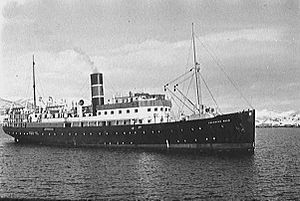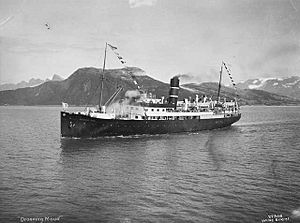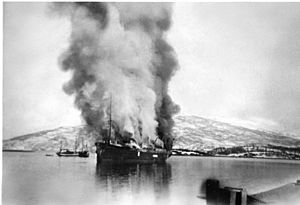SS Dronning Maud (1925) facts for kids

Dronning Maud in 1936
|
|
Quick facts for kids History |
|
|---|---|
| Name | Dronning Maud |
| Namesake | Queen Maud of Norway |
| Owner | Det Nordenfjeldske Dampskipsselskap |
| Port of registry | Trondheim |
| Route | Hurtigruten |
| Ordered | June 1924 |
| Builder | Fredrikstad Mekaniske Verksted |
| Cost | 2,000,000 kr |
| Yard number | 246 |
| Launched | 8 May 1925 |
| Christened | 30 June 1925 |
| Commissioned | 3 July 1925 |
| Maiden voyage | 30 June 1925 |
| In service | 13 July 1925 |
| Out of service | 1 May 1940 |
| Identification | |
| Fate | Sunk by German aircraft |
| General characteristics | |
| Type |
|
| Tonnage | 1,489 gross register tons (GRT) |
| Length | 235 ft (71.63 m) |
| Beam | 11.5 ft (3.51 m) |
| Propulsion | 1,500 hp triple expansion steam engine |
| Speed |
|
| Capacity | 400 passengers (1925) |
| Armament |
|
The SS Dronning Maud was a large steamship built in Norway in 1925. She weighed 1,489 tons and was made of steel. The ship was built by Fredrikstad Mekaniske Verksted in Fredrikstad.
Dronning Maud was ordered by a company from Trondheim called Det Nordenfjeldske Dampskipsselskap. Her job was to carry passengers and goods along the coast of Norway on a route called Hurtigruten. She was the main ship, or flagship, for her company on this route. Sadly, she was sunk in 1940 during the Norwegian Campaign in a way that caused much debate.
Contents
Life Before World War II
Building and First Journey
Dronning Maud was ordered after another ship, the Haakon Jarl, was lost. Haakon Jarl had crashed with another ship in 1924 and sank. Many people died in that accident.
Dronning Maud was the first new ship to join the Hurtigruten route since 1912. She was launched on May 8, 1925. Her first test run was on June 30, 1925. The ship was officially given to her owners on July 3. She then sailed north to Trondheim. Her first trip on the Hurtigruten service began on July 13, 1925.
Ship Features and Safety
Dronning Maud brought new ideas to the Hurtigruten ships. The First Class section was moved to the middle of the ship. The Second Class was removed completely. This made more space for a much better Third Class section at the back. People at the time said the Third Class areas were "light and practical."
The ship looked sleek and modern. She had a large upper structure and a long deck for walking. She was known as a very strong ship that could handle rough seas. In 1931, she became the first Hurtigruten ship to get a new safety feature: wireless telegraphy. This allowed her to send and receive messages by radio. By 1936, all Hurtigruten ships had this important technology.
Regular Coastal Service
After she started working, Dronning Maud carried people and cargo along the Norwegian coast. During her normal trips in the 1920s and 1930s, she often helped other ships in trouble. In 1926, she helped a steamer called Pallas that had run aground. In 1927, she helped a British fishing boat that was stuck. Dronning Maud herself had an accident in October 1929 when she ran aground near Florø.
During World War II
When Second World War started, Norway said it would stay neutral. The Hurtigruten service continued as usual for the first few months.
A Daring Rescue Mission
On January 1, 1940, Dronning Maud was part of an amazing rescue. A German merchant ship, the Johann Schulte, lost its propeller and was shipwrecked. It was a stormy night with strong winds and snow. Captain Edward M. Grundt of Dronning Maud brought his ship very close to the German vessel. A rope was thrown, and all 36 German sailors and two Norwegian pilots were pulled to safety.
The rescue happened at night in complete darkness. About 100 passengers and 45 crew were on board Dronning Maud. After everyone was safe, the German ship hit a reef and was destroyed. The rescued Germans were taken ashore. This rescue was called one of the most incredible ever on the Norwegian coast. Captain Grundt later received a gold medal for his brave actions.
The Norwegian Campaign
Helping Troops Move
When Germany invaded Norway on April 9, 1940, Dronning Maud was sailing north. She continued to her final port of Kirkenes. There, the Norwegian government took control of her to use her as a troopship. This meant she would carry soldiers.
Her first job was to help transport soldiers from Sør-Varanger to the Tromsø-Narvik area. She sailed with British warships and other smaller Norwegian ships. They dropped off most of the soldiers on April 16, 1940. The next day, Dronning Maud continued north with another ship.
Her second troop transport mission was to carry more soldiers from Alta to areas closer to the front lines. She sailed with two other ships. Each ship had machine guns for anti-aircraft defense. Dronning Maud arrived in Tromsø on April 20. After a short stop, she continued south and dropped off the troops.
After these missions, the Norwegian authorities decided to use Dronning Maud to carry a medical company. This group had 119 medics, eight horses, and three trucks. To show she was a medical ship, Dronning Maud had a large Red Cross flag on her bridge deck. She also flew two more Red Cross flags on her masts.
The Final Journey
Dronning Maud left Sørreisa around 11:30 AM on May 1, 1940. She arrived at Foldvik a few hours later. The weather was calm and sunny. As the ship was about to dock, two or three German aircraft attacked her. They dropped bombs and fired machine guns.
Seven bombs were dropped. Two hit the ship directly. One bomb hit near the engine room, blowing out the ship's sides. The other exploded in the bottom of the hull. The first bomb killed everyone in the refrigeration room. As the crew and passengers tried to leave the ship, only one or two lifeboats could be launched because of the fire. The fire also threatened the wooden dock. A local fishing boat managed to pull the burning ship away from the shore. Dronning Maud drifted a short distance, then ran aground. She burned and sank, leaning to one side.
After attacking Dronning Maud, the German planes bombed nearby Gratangen. Several houses were destroyed, and two civilians died.
After the attack, the wounded survivors were given first aid by the crew of a hospital ship called Elieser. The British destroyer HMS Cossack took the most seriously wounded to a hospital. Elieser took those less hurt to another location.
Nine medics died during the attack. Another died later in a hospital. Eight of the ship's crew also died. All the equipment on board was lost when Dronning Maud sank. Thirty-one medics and crew members were injured.
The wreck of Dronning Maud is still where she sank. She rests upright about 26 to 35 meters (85 to 115 feet) deep.
Reactions to the Sinking
The sinking of Dronning Maud caused a lot of anger and criticism against the Germans. This was because she was an unarmed ship. She was also flying Red Cross flags and carrying medical staff. From Norway's view, Dronning Maud was a hospital ship. This meant she should have been protected by the Geneva Conventions.
The Germans said that Dronning Maud was not fully marked as a hospital ship. They pointed out that her hull was still black. A hospital ship's hull should be painted white with a green stripe.
Images for kids






